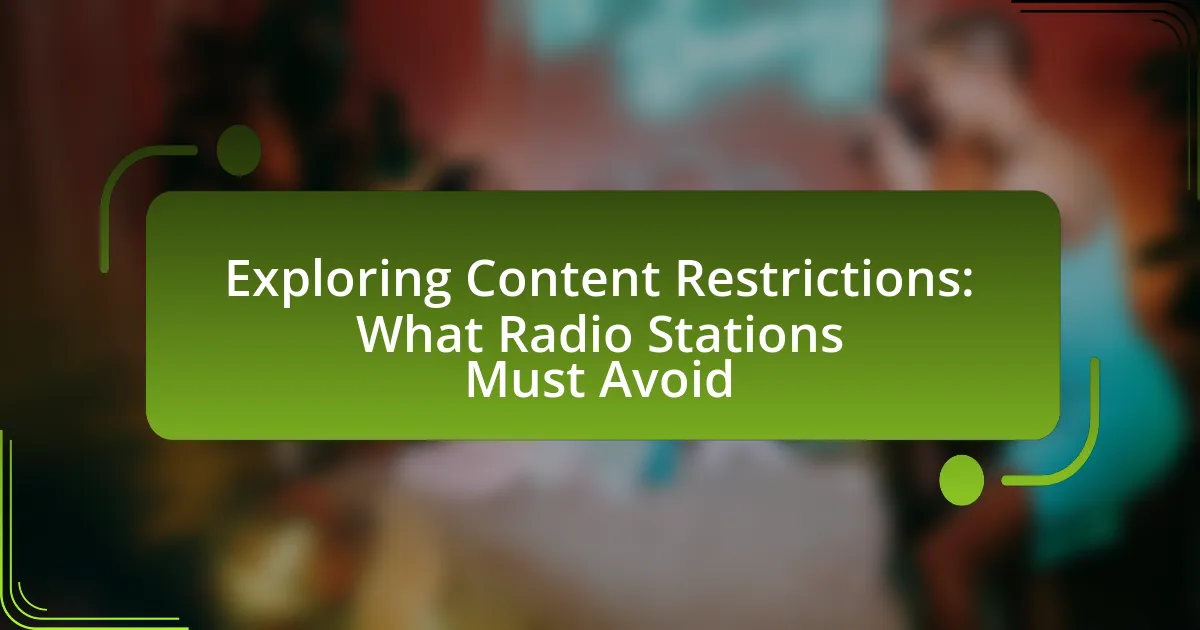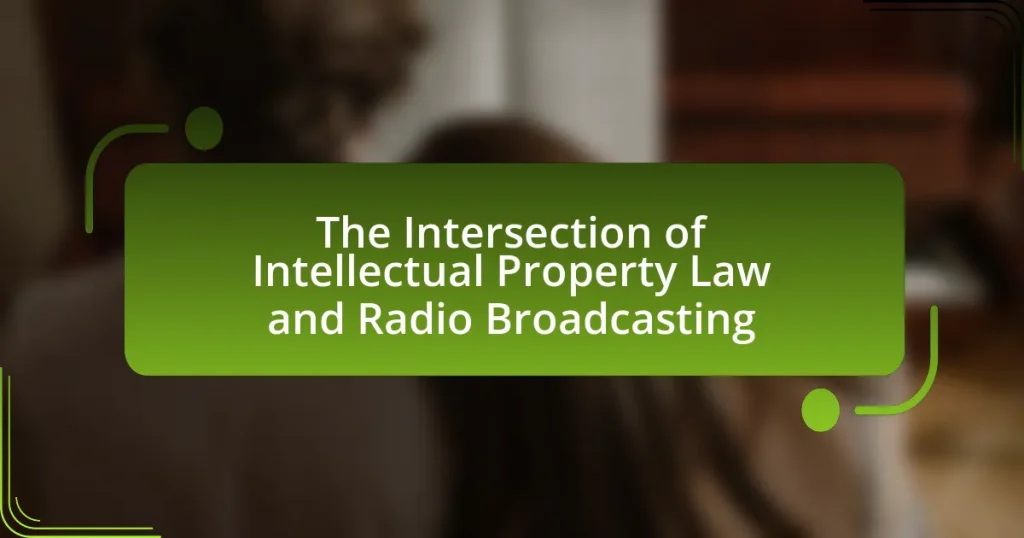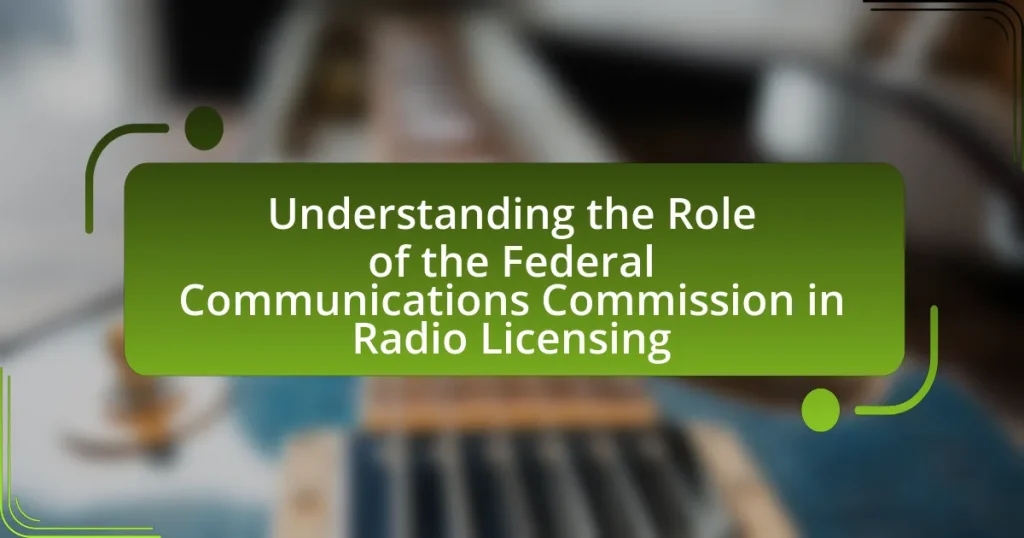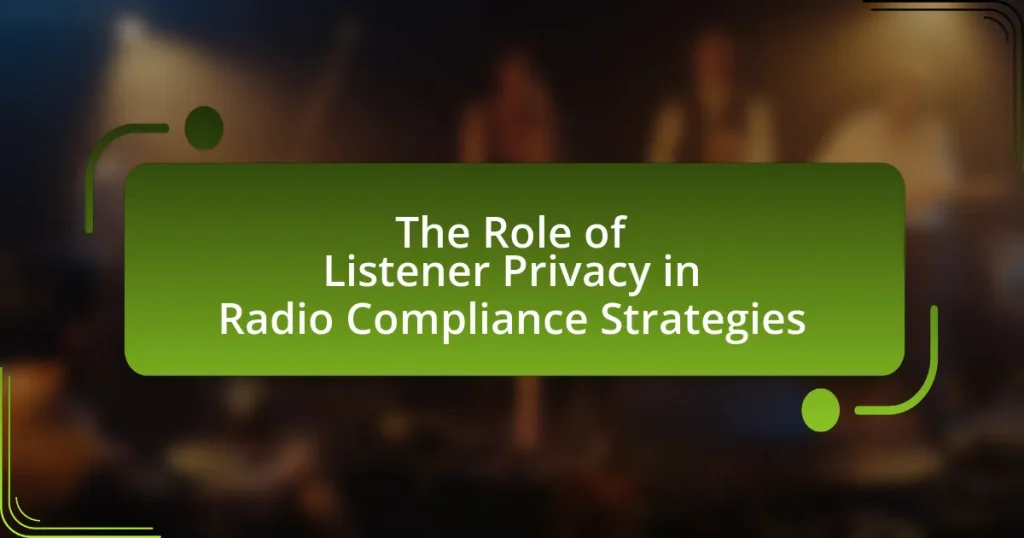The article focuses on the key content restrictions that radio stations must adhere to, primarily mandated by the Federal Communications Commission (FCC) in the United States. It outlines prohibitions against broadcasting obscene, indecent, or profane material, as well as false or misleading information, hate speech, and content that incites violence. The article further explores the legal frameworks governing these restrictions, the consequences of non-compliance, and best practices for ensuring adherence to regulations. Additionally, it discusses emerging trends in content restrictions influenced by technology and public opinion, highlighting the challenges and strategies radio stations may face in navigating evolving content policies.
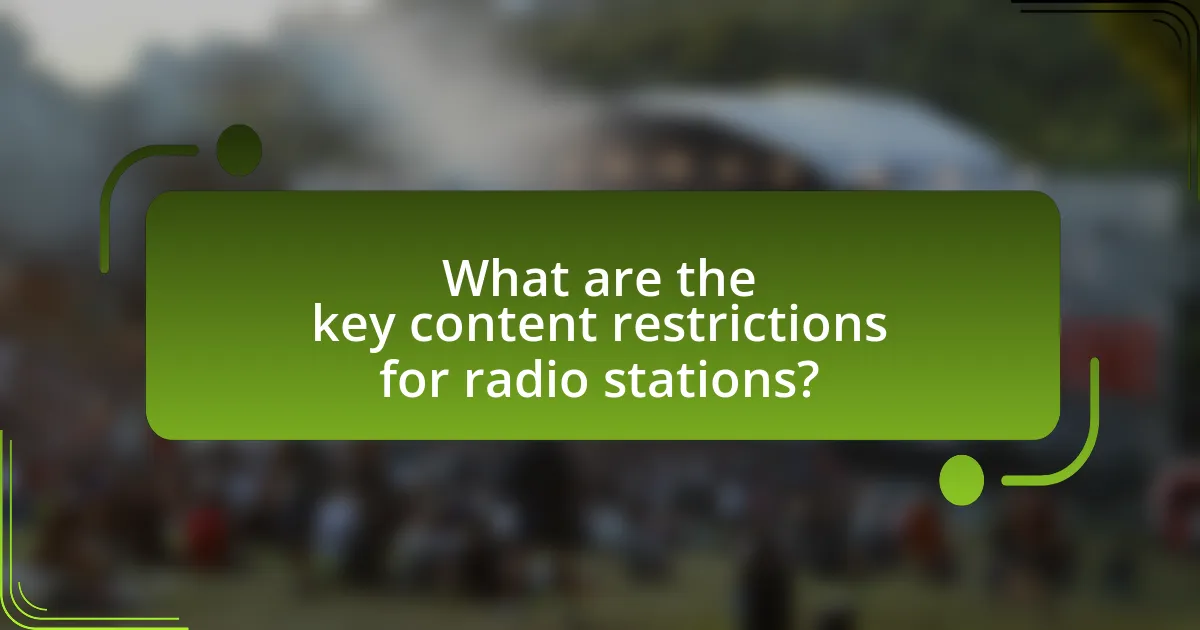
What are the key content restrictions for radio stations?
Key content restrictions for radio stations include prohibitions against broadcasting obscene, indecent, or profane material, as mandated by the Federal Communications Commission (FCC). These regulations are designed to protect audiences, particularly minors, from exposure to inappropriate content. Additionally, radio stations must avoid airing false or misleading information, which can lead to legal repercussions and loss of license. The FCC also enforces rules against hate speech and incitement to violence, ensuring that broadcasts do not promote discrimination or harm against individuals or groups.
Why do radio stations have content restrictions?
Radio stations have content restrictions primarily to comply with legal regulations and community standards. These restrictions are enforced by government agencies, such as the Federal Communications Commission (FCC) in the United States, which sets guidelines to prevent the broadcast of obscene, indecent, or profane material. For instance, the FCC prohibits the airing of indecent content during certain hours when children are likely to be listening, ensuring that programming is appropriate for all audiences. Additionally, radio stations aim to maintain their reputation and listener trust by adhering to societal norms and expectations regarding sensitive topics, such as violence, hate speech, and explicit language.
What legal frameworks govern content restrictions in radio broadcasting?
The legal frameworks governing content restrictions in radio broadcasting primarily include the Communications Act of 1934, the Federal Communications Commission (FCC) regulations, and various state laws. The Communications Act establishes the regulatory authority of the FCC, which enforces rules regarding indecency, obscenity, and profanity in broadcasting. For instance, the FCC prohibits the broadcast of obscene material at any time and restricts indecent content during certain hours to protect minors. Additionally, state laws may impose further restrictions based on local community standards. These frameworks ensure that radio content adheres to legal and ethical standards, safeguarding public interest and promoting responsible broadcasting.
How do content restrictions vary by country or region?
Content restrictions vary significantly by country or region due to differing cultural norms, legal frameworks, and government policies. For instance, countries like China impose strict censorship laws that limit access to information deemed politically sensitive, while in the United States, the First Amendment protects freedom of speech, allowing for broader content dissemination. Additionally, regions such as the Middle East may enforce restrictions based on religious beliefs, affecting the types of content that can be broadcast. These variations are often codified in national laws and regulations, reflecting the unique societal values and political climates of each area.
What types of content are typically restricted?
Content that is typically restricted includes hate speech, explicit sexual content, and material promoting violence or illegal activities. Radio stations must adhere to regulations set by governing bodies, such as the Federal Communications Commission (FCC) in the United States, which prohibits broadcasting obscene content and restricts indecent material during certain hours. Additionally, content that incites panic or promotes discrimination based on race, gender, or religion is also restricted to ensure public safety and uphold community standards.
What constitutes hate speech in radio content?
Hate speech in radio content constitutes any communication that incites violence, discrimination, or hostility against individuals or groups based on attributes such as race, ethnicity, nationality, religion, gender, sexual orientation, or disability. This definition aligns with legal frameworks, such as the International Covenant on Civil and Political Rights, which emphasizes the prohibition of advocacy of national, racial, or religious hatred that constitutes incitement to discrimination, hostility, or violence. Furthermore, the Federal Communications Commission (FCC) in the United States outlines that broadcasting content that promotes hate speech can lead to penalties, reinforcing the need for radio stations to avoid such content to comply with regulations and maintain ethical broadcasting standards.
How is explicit content defined and regulated?
Explicit content is defined as material that contains graphic depictions of sexual acts, extreme violence, or other themes that may be deemed inappropriate for certain audiences. Regulation of explicit content is primarily enforced through laws and guidelines established by government agencies, such as the Federal Communications Commission (FCC) in the United States, which prohibits broadcasting obscene material and restricts indecent content during specific hours. Additionally, the industry often adheres to self-regulatory standards set by organizations like the Motion Picture Association (MPA) and the Recording Industry Association of America (RIAA), which provide ratings and advisories to inform consumers about the nature of the content. These regulations aim to protect minors and maintain community standards, reflecting societal values regarding acceptable content.
What are the consequences of violating content restrictions?
Violating content restrictions can lead to severe penalties for radio stations, including fines, license suspension, or revocation. Regulatory bodies, such as the Federal Communications Commission (FCC) in the United States, impose these consequences to ensure compliance with broadcasting standards. For instance, the FCC can impose fines that range from thousands to millions of dollars depending on the severity of the violation, as seen in cases where stations aired indecent material during prohibited hours. Additionally, repeated violations can result in the loss of broadcasting licenses, which directly impacts a station’s ability to operate legally.
What penalties can radio stations face for non-compliance?
Radio stations can face penalties such as fines, license suspension, or revocation for non-compliance with regulations. The Federal Communications Commission (FCC) enforces these penalties, which can amount to thousands of dollars per violation, depending on the severity and frequency of the infractions. For instance, in 2020, the FCC imposed a $1.5 million fine on a radio station for multiple violations, demonstrating the financial repercussions of non-compliance.
How can violations impact a station’s reputation?
Violations can severely damage a station’s reputation by eroding listener trust and credibility. When a station fails to adhere to content regulations or ethical standards, it risks alienating its audience, which can lead to decreased listenership and advertising revenue. For instance, a study by the Pew Research Center found that 63% of listeners are less likely to support a station that has faced legal issues or ethical violations. This decline in public perception can result in long-term financial consequences and hinder the station’s ability to attract quality talent and partnerships.

How can radio stations ensure compliance with content restrictions?
Radio stations can ensure compliance with content restrictions by implementing strict content review processes and training staff on regulatory guidelines. Establishing a dedicated compliance team to monitor broadcasts and review content before airing helps identify potential violations. Additionally, utilizing automated content monitoring systems can flag inappropriate material in real-time, ensuring adherence to Federal Communications Commission (FCC) regulations, which mandate specific content standards. Regular audits and updates to compliance protocols based on changes in legislation further reinforce adherence to content restrictions.
What best practices should radio stations follow?
Radio stations should prioritize compliance with broadcasting regulations, audience engagement, and content diversity. Compliance with regulations, such as those set by the Federal Communications Commission (FCC) in the United States, ensures that stations avoid legal issues and maintain their licenses. Engaging with the audience through interactive programming and social media fosters a loyal listener base, as evidenced by studies showing that stations with active listener participation experience higher ratings. Additionally, offering diverse content that reflects various demographics and interests not only attracts a broader audience but also adheres to public interest standards, which can enhance community support and sponsorship opportunities.
How can training staff help in adhering to content restrictions?
Training staff can significantly enhance adherence to content restrictions by providing them with clear guidelines and understanding of regulatory requirements. When staff members are educated about specific content limitations, such as those related to offensive language, copyright issues, or sensitive topics, they are better equipped to make informed decisions during content creation and broadcasting. Research indicates that organizations with comprehensive training programs experience a 50% reduction in compliance violations, demonstrating the effectiveness of training in promoting adherence to established standards.
What role does content review play in compliance?
Content review plays a critical role in compliance by ensuring that all broadcast material adheres to legal and regulatory standards. This process involves systematically evaluating content to identify and eliminate any elements that may violate laws, such as copyright infringement, indecency, or misinformation. For instance, the Federal Communications Commission (FCC) mandates that radio stations must not air obscene material, and content review helps prevent such violations, thereby protecting the station from potential fines or legal action. By implementing thorough content review practices, radio stations can maintain compliance, safeguard their licenses, and uphold their reputations in the industry.
What resources are available for understanding content restrictions?
Resources available for understanding content restrictions include regulatory guidelines from organizations such as the Federal Communications Commission (FCC) in the United States, which outlines prohibited content for radio stations. Additionally, industry publications like the “Radio and Television Digital News Association” provide insights into ethical standards and legal considerations. Academic research, such as studies published in the “Journal of Broadcasting & Electronic Media,” also offers analysis on content limitations and compliance. These resources collectively help radio stations navigate the complexities of content restrictions effectively.
Where can radio stations find legal guidelines and updates?
Radio stations can find legal guidelines and updates through the Federal Communications Commission (FCC) website, which provides comprehensive resources on broadcasting regulations. The FCC regularly publishes updates, rulings, and guidelines that are essential for compliance with federal laws governing radio operations. Additionally, industry organizations such as the National Association of Broadcasters (NAB) offer resources, training, and legal updates relevant to radio stations. These sources ensure that radio stations stay informed about the latest legal requirements and best practices in broadcasting.
How can industry associations assist in compliance efforts?
Industry associations can assist in compliance efforts by providing resources, guidance, and advocacy for regulatory adherence. These associations often develop best practice guidelines tailored to industry standards, which help members understand and implement compliance measures effectively. For instance, the National Association of Broadcasters offers training programs and compliance checklists that radio stations can utilize to navigate content restrictions. Additionally, industry associations engage with regulatory bodies to advocate for fair policies, ensuring that the concerns of their members are represented in compliance discussions. This dual approach of education and advocacy enhances the ability of radio stations to meet legal requirements while promoting industry standards.
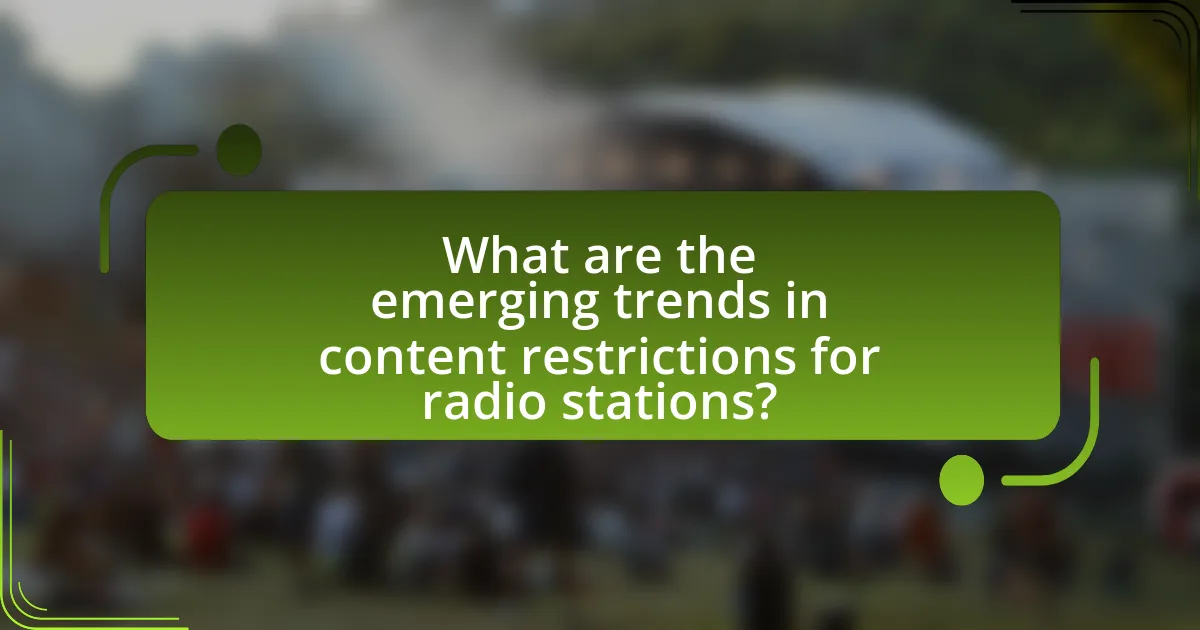
What are the emerging trends in content restrictions for radio stations?
Emerging trends in content restrictions for radio stations include increased scrutiny on hate speech, misinformation, and the promotion of harmful behaviors. Regulatory bodies, such as the Federal Communications Commission (FCC) in the United States, are tightening guidelines to ensure that content does not incite violence or spread false information, particularly in the context of political discourse and public health. For instance, the rise of misinformation during the COVID-19 pandemic has led to more stringent measures against broadcasting unverified claims. Additionally, there is a growing emphasis on protecting vulnerable populations from discriminatory language and content, reflecting broader societal movements towards inclusivity and accountability in media.
How is technology influencing content restrictions?
Technology is significantly influencing content restrictions by enabling more sophisticated monitoring and filtering systems. These advancements allow regulatory bodies and platforms to automatically detect and restrict content that violates guidelines, such as hate speech or copyright infringement. For instance, algorithms used by social media platforms can analyze vast amounts of data in real-time, identifying and flagging inappropriate content based on predefined criteria. This capability has led to stricter enforcement of content policies, as seen in the implementation of the Digital Services Act in the European Union, which mandates platforms to take responsibility for harmful content.
What impact do social media and digital platforms have on radio content regulations?
Social media and digital platforms significantly influence radio content regulations by introducing new standards for content dissemination and audience engagement. These platforms enable immediate feedback and interaction, prompting regulatory bodies to adapt existing rules to address issues such as misinformation, hate speech, and copyright infringement. For instance, the Federal Communications Commission (FCC) has acknowledged the need to consider the impact of online content on traditional broadcasting, leading to discussions about harmonizing regulations across media types. This shift reflects the growing convergence of media platforms, where content shared on social media can quickly reach a wide audience, necessitating stricter compliance with established broadcasting standards to maintain public trust and safety.
How are listener feedback and public opinion shaping content policies?
Listener feedback and public opinion significantly shape content policies by influencing the decisions made by radio stations regarding programming and content restrictions. Radio stations actively monitor listener feedback through surveys, social media interactions, and audience ratings, which provide insights into audience preferences and sensitivities. For instance, a study by the Pew Research Center found that 62% of Americans believe that media should reflect diverse viewpoints, prompting stations to adjust their content to align with public expectations and avoid backlash. Consequently, radio stations implement content policies that prioritize listener preferences, ensuring compliance with community standards and legal regulations to maintain their audience base and avoid potential controversies.
What future challenges might radio stations face regarding content restrictions?
Radio stations may face significant challenges regarding content restrictions due to evolving regulations and societal expectations. As governments and regulatory bodies adapt to changes in technology and public sentiment, radio stations must navigate stricter guidelines on hate speech, misinformation, and copyright issues. For instance, the Federal Communications Commission (FCC) has been known to update its policies in response to public outcry over harmful content, which can lead to increased scrutiny and potential penalties for non-compliance. Additionally, the rise of digital platforms has created competition that influences content standards, pushing radio stations to align with broader media trends while adhering to legal constraints.
How could changes in legislation affect radio content in the coming years?
Changes in legislation could significantly alter radio content by imposing stricter regulations on content standards and broadcasting practices. For instance, recent legislative trends have focused on increasing accountability for misinformation and hate speech, which may lead to more stringent content moderation requirements for radio stations. Additionally, laws aimed at protecting consumer privacy could restrict how stations collect and use listener data, impacting targeted advertising and content personalization. Historical examples include the implementation of the Telecommunications Act of 1996, which reshaped ownership rules and content diversity, demonstrating how legislative changes can directly influence the nature and variety of radio programming.
What strategies can radio stations adopt to adapt to evolving restrictions?
Radio stations can adopt several strategies to adapt to evolving restrictions, including diversifying content formats, enhancing digital presence, and implementing compliance training. Diversifying content formats allows stations to reach broader audiences and comply with varying regulations across platforms. Enhancing digital presence through streaming services and social media engagement helps maintain listener connection and adapt to changes in consumption habits. Implementing compliance training ensures that staff are aware of current regulations and can navigate restrictions effectively, reducing the risk of violations. These strategies are essential for maintaining relevance and operational integrity in a changing regulatory landscape.
What practical steps can radio stations take to navigate content restrictions effectively?
Radio stations can navigate content restrictions effectively by implementing a comprehensive compliance strategy that includes regular training for staff on legal guidelines, establishing clear content review processes, and utilizing technology for content monitoring. Regular training ensures that all personnel are aware of the latest regulations, such as those set by the Federal Communications Commission (FCC) in the United States, which governs broadcasting standards. Establishing a content review process allows stations to vet material before airing, reducing the risk of violations. Additionally, employing content monitoring technology can help identify potential issues in real-time, allowing for swift corrective actions. These steps collectively enhance a station’s ability to adhere to content restrictions while maintaining quality programming.
